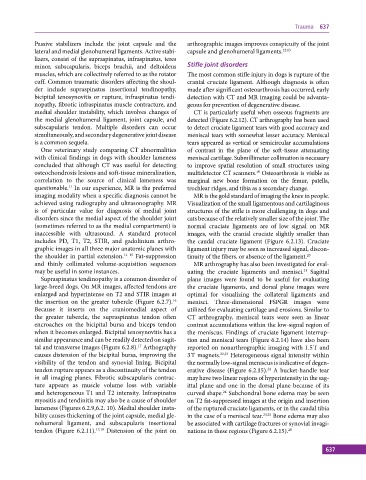Page 647 - Atlas of Small Animal CT and MRI
P. 647
Trauma 637
Passive stabilizers include the joint capsule and the arthrographic images improves conspicuity of the joint
lateral and medial glenohumeral ligaments. Active stabi- capsule and glenohumeral ligaments. 12,13
lizers, consist of the supraspinatus, infraspinatus, teres
minor, subscapularis, biceps brachii, and deltoideus Stifle joint disorders
muscles, which are collectively referred to as the rotator The most common stifle injury in dogs is rupture of the
cuff. Common traumatic disorders affecting the shoul- cranial cruciate ligament. Although diagnosis is often
der include supraspinatus insertional tendinopathy, made after significant osteoarthrosis has occurred, early
bicipital tenosynovitis or rupture, infraspinatus tendi- detection with CT and MR imaging could be advanta-
nopathy, fibrotic infraspinatus muscle contracture, and geous for prevention of degenerative disease.
medial shoulder instability, which involves changes of CT is particularly useful when osseous fragments are
the medial glenohumeral ligament, joint capsule, and detected (Figure 6.2.12). CT arthrography has been used
subscapularis tendon. Multiple disorders can occur to detect cruciate ligament tears with good accuracy and
simultaneously, and secondary degenerative joint disease meniscal tears with somewhat lesser accuracy. Meniscal
is a common sequela. tears appeared as vertical or semicircular accumulations
One veterinary study comparing CT abnormalities of contrast in the plane of the soft‐tissue attenuating
with clinical findings in dogs with shoulder lameness meniscal cartilage. Submillimeter collimation is necessary
concluded that although CT was useful for detecting to improve spatial resolution of small structures using
osteochondrosis lesions and soft‐tissue mineralization, multidetector CT scanners. Osteoarthrosis is visible as
19
correlation to the source of clinical lameness was marginal new bone formation on the femur, patella,
11
questionable. In our experience, MR is the preferred trochlear ridges, and tibia as a secondary change.
imaging modality when a specific diagnosis cannot be MR is the gold standard of imaging the knee in people.
achieved using radiography and ultrasonography. MR Visualization of the small ligamentous and cartilaginous
is of particular value for diagnosis of medial joint structures of the stifle is more challenging in dogs and
disorders since the medial aspect of the shoulder joint cats because of the relatively smaller size of the joint. The
(sometimes referred to as the medial compartment) is normal cruciate ligaments are of low signal on MR
inaccessible with ultrasound. A standard protocol images, with the cranial cruciate slightly smaller than
includes PD, T1, T2, STIR, and gadolinium arthro- the caudal cruciate ligament (Figure 6.2.13). Cruciate
graphic images in all three major anatomic planes with ligament injury may be seen as increased signal, discon-
the shoulder in partial extension. 12–15 Fat‐suppression tinuity of the fibers, or absence of the ligament. 20
and thinly collimated volume‐acquisition sequences MR arthrography has also been investigated for eval-
may be useful in some instances. uating the cruciate ligaments and menisci. Sagittal
21
Supraspinatus tendinopathy is a common disorder of plane images were found to be useful for evaluating
large‐breed dogs. On MR images, affected tendons are the cruciate ligaments, and dorsal plane images were
enlarged and hyperintense on T2 and STIR images at optimal for visualizing the collateral ligaments and
the insertion on the greater tubercle (Figure 6.2.7). menisci. Three‐dimensional FSPGR images were
16
Because it inserts on the craniomedial aspect of utilized for evaluating cartilage and erosions. Similar to
the greater tubercle, the supraspinatus tendon often CT arthrography, meniscal tears were seen as linear
encroaches on the bicipital bursa and biceps tendon contrast accumulations within the low‐signal region of
when it becomes enlarged. Bicipital tenosynovitis has a the meniscus. Findings of cruciate ligament interrup-
similar appearance and can be readily detected on sagit- tion and meniscal tears (Figure 6.2.14) have also been
tal and transverse images (Figure 6.2.8). Arthography reported on nonarthrographic imaging with 1.5 T and
17
causes distension of the bicipital bursa, improving the 3 T magnets. 22,23 Heterogeneous signal intensity within
visibility of the tendon and synovial lining. Bicipital the normally low‐signal meniscus is indicative of degen-
tendon rupture appears as a discontinuity of the tendon erative disease (Figure 6.2.15). A bucket‐handle tear
24
in all imaging planes. Fibrotic subscapularis contrac- may have two linear regions of hyperintensity in the sag-
ture appears as muscle volume loss with variable ittal plane and one in the dorsal plane because of its
and heterogeneous T1 and T2 intensity. Infraspinatus curved shape. Subchondral bone edema may be seen
24
myositis and tendinitis may also be a cause of shoulder on T2 fat‐suppressed images at the origin and insertion
lameness (Figures 6.2.9,6.2. 10). Medial shoulder insta- of the ruptured cruciate ligaments, or in the caudal tibia
bility causes thickening of the joint capsule, medial gle- in the case of a meniscal tear. 24,25 Bone edema may also
nohumeral ligament, and subscapularis insertional be associated with cartilage fractures or synovial invagi-
tendon (Figure 6.2.11). 17,18 Distension of the joint on nations in these regions (Figure 6.2.15). 20
637

